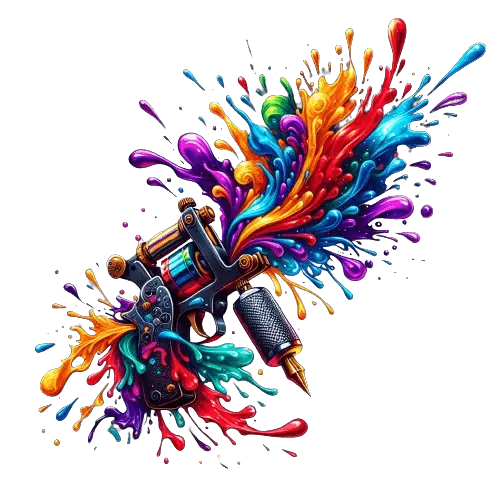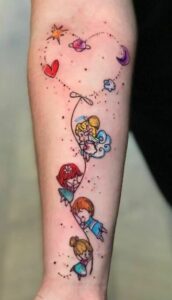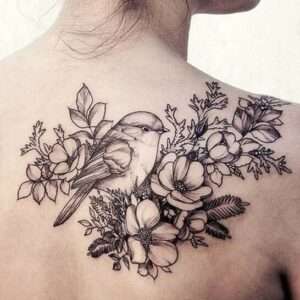Japanese crane tattoos symbolize longevity, luck, and fidelity. These elegant creatures hold deep cultural significance in japan and have been revered for centuries.
The crane’s graceful movements and timeless beauty capture the imagination, making it a popular choice for body art. Its association with luck and longevity makes it an ideal choice for those seeking a tattoo with a positive and meaningful message.
The crane is often depicted in various poses, from soaring in flight to standing gracefully amidst water or cherry blossoms. Its symbolism extends beyond aesthetics, representing inner strength, resilience, and tranquility. Whether one chooses a simple black ink design or a vibrant and detailed artwork, a Japanese crane tattoo is a timeless symbol that embodies these powerful qualities.
The Symbolism Of The Crane In Japanese Culture
Japanese Crane Tattoo Meaning
Japanese culture is rich in symbolism, and one of the most significant symbols is the crane. The crane holds a special place in japanese mythology, folklore, and art, representing various virtues and beliefs. In this blog post, we will explore the deep cultural roots of crane symbolism in japan and delve into the profound meanings behind this majestic bird.
The Significance Of Cranes In Japanese Mythology And Folklore
- Cranes are considered sacred creatures in japanese mythology, believed to be messengers of the gods.
- In japanese folklore, cranes are often associated with mystical beings and are seen as beings of great wisdom and supernatural power.
- There are countless tales and legends featuring cranes, ranging from stories of their ability to transform into humans to narratives of their role in granting wishes.
The Association Between Cranes And Longevity, Wisdom, And Good Fortune
- The crane is regarded as a powerful symbol of longevity in japanese culture due to its lifespan, which is said to be 1,000 years.
- Cranes are also considered embodiments of wisdom, thought to possess profound knowledge and insight.
- Furthermore, cranes are believed to bring good fortune to those who encounter them, symbolizing prosperity and blessings.
Exploring The Deep Cultural Roots Of Crane Symbolism In Japan
- The significance of cranes in japanese culture can be traced back to ancient times, where they were highly revered and celebrated.
- Cranes are frequently depicted in traditional japanese art forms like paintings, pottery, and kimono patterns, showcasing their cultural importance.
- The graceful and elegant movements of cranes have inspired various forms of traditional japanese dances, such as the famous dance known as “kuruma ningyo,” or the “crane puppet dance.”
The crane tattoo holds great symbolism in japanese culture, representing longevity, wisdom, and good fortune. By understanding the deep cultural roots and significance of the crane, we gain a deeper appreciation for this magnificent creature and its role in japanese art, mythology, and folklore.
Whether you are considering getting a japanese crane tattoo or simply want to learn more about japanese symbolism, the crane’s powerful and profound meanings are sure to captivate and inspire.
The Historical Context Of Japanese Crane Tattoos
Japanese crane tattoos have a rich and fascinating history, rooted in the cultural fabric of japan. These tattoos have become increasingly popular in recent years, attracting individuals from all walks of life. To truly understand the meaning behind japanese crane tattoos, it is essential to delve into their historical context.
This exploration will take us on a journey tracing the origins of japanese tattoo art, exploring the evolution of tattooing in japan and its cultural significance, and understanding how the crane tattoo became a beloved symbol in japanese tattooing tradition.
So let’s start our journey and uncover the captivating story behind japanese crane tattoos.
Tracing The Origins Of Japanese Tattoo Art:
- Tattoos in japan have a long history, dating back thousands of years.
- The earliest known evidence of tattooing in japan can be traced as far back as the jomon period (10,000-300 bce).
- Traditional japanese tattooing, known as irezumi, was influenced by various cultures throughout history, including china and polynesia.
- Irezumi initially served as a form of spiritual and decorative expression, often used to signify status or ward off evil spirits.
The Evolution Of Tattooing In Japan And Its Cultural Significance:
- During the edo period (1603-1868), tattooing in japan went through a significant shift in perception.
- Tattooing was associated with criminals and outcasts, leading to its practice being outlawed.
- Despite this, tattooing continued to thrive underground and became associated with marginalized communities such as kabuki actors, firefighters, and the yakuza.
- In recent years, attitudes towards tattoos have shifted, and they are becoming more accepted as a form of self-expression and artistry in japanese society.
How The Crane Tattoo Became Popular In Japanese Tattooing Tradition:
- In japanese culture, the crane is a symbol of longevity, good fortune, and fidelity.
- The popularity of crane tattoos can be attributed to their presence in traditional japanese art, such as ukiyo-e prints and woodblock paintings.
- The intricate and graceful nature of the crane makes it a captivating choice for tattoo enthusiasts.
- Crane tattoos are often depicted in various poses, such as flying, dancing, or surrounded by cherry blossoms, each carrying its unique symbolism.
Japanese crane tattoos hold a significant place in the world of tattoo art, representing not only aesthetic beauty but also deep cultural meaning. Their historical context tells a story of transformation, from a marginalized art form to a revered and celebrated tradition.
As we delve deeper into the intricacies of japanese crane tattoos, we will unravel the depths of their symbolism and understand why they continue to captivate and inspire countless individuals seeking to adorn their bodies with a meaningful and timeless piece of art.
Decoding The Symbolism Of The Japanese Crane Tattoo
The representation of grace and elegance through the crane tattoo:
- The japanese crane tattoo holds deep symbolism and meaning.
- One of the key aspects of the crane tattoo is its embodiment of grace and elegance.
- The crane, known as “tsuru” in japanese, is revered for its majestic and graceful presence.
- The crane’s long legs and slender body exude a sense of poise and beauty, making it an ideal choice for those seeking a tattoo that symbolizes elegance.
- The intricate details and flowing lines of the crane tattoo further enhance its representation of grace and beauty.
- The crane’s gentle movements and graceful flight inspire a sense of awe and admiration, making it a powerful symbol to capture in tattoo form.
Connecting the crane tattoo with concepts of serenity and peace:
- In addition to its representation of grace and elegance, the crane tattoo is also deeply connected to concepts of serenity and peace.
- The crane is often associated with tranquility due to its serene nature and graceful movements.
- Its calm demeanor and ability to gracefully navigate through the air and water reflect qualities of peace and tranquility.
- The crane’s wings, often depicted with intricate patterns and vibrant colors, symbolize freedom and the ability to soar above life’s challenges.
- Those who choose the crane tattoo may seek to embody these qualities of serenity, peace, and the ability to overcome obstacles with grace and ease.
Exploring the spiritual and mystical associations of the crane tattoo:
- Beyond its physical characteristics, the crane tattoo carries deep spiritual and mystical associations.
- In japanese folklore, the crane is believed to be a sacred creature, associated with longevity and good fortune.
- Cranes are often depicted alongside iconic figures in japanese mythology, representing divine intervention and protection.
- The crane’s elegance and symbolism have made it a popular motif in traditional japanese art, representing purity, wisdom, and spiritual enlightenment.
- The crane tattoo can serve as a reminder of the interconnectedness of the physical and spiritual realms, reminding the wearer of the importance of balance and harmony in their own lives.
- Whether chosen for its visual appeal or its spiritual significance, the crane tattoo is a timeless symbol that speaks to one’s inner beauty, grace, and spiritual journey.
Variations Of Japanese Crane Tattoos And Their Meanings
Japanese crane tattoos are not only visually stunning but also rich in symbolism. These elegant birds hold great significance in japanese culture, representing longevity, good fortune, and loyalty. As with any tattoo design, variations can be found, each with its own unique meaning.
In this section, we will explore the different artistic interpretations of crane tattoos, the significance of color and pose, and their connections with other elements in japanese art.
The Different Artistic Interpretations Of Crane Tattoos:
- Realistic representation: Many people opt for a realistic portrayal of a japanese crane in their tattoo design. This allows for intricate details, capturing the grace and beauty of the bird.
- Traditional japanese style: For those seeking a more traditional look, crane tattoos inspired by ukiyo-e woodblock prints can be a popular choice. These tattoos often feature bold outlines and vibrant colors.
- Modern and abstract designs: Some individuals prefer to take a more contemporary approach, opting for abstract or stylized interpretations of cranes. These tattoos can incorporate geometric shapes or incorporate other artistic elements.
Significance Of Color And Pose In Crane Tattoos:
- Crane tattoos can come in various colors, each carrying its own symbolic meaning. For example:
- A white crane symbolizes purity, innocence, and peace.
- A black crane represents strength, power, and wisdom.
- A red crane is associated with fire, passion, and vitality.
- The pose of the crane in a tattoo can also hold significance. For instance:
- A crane in flight signifies freedom and transcendence.
- A crane with a raised wing represents good luck and protection.
- A pair of cranes dancing together symbolizes love, harmony, and a lasting bond.
Crane Tattoos And Their Connections With Other Elements In Japanese Art:
- Waves and water: The crane and waves often go hand in hand in japanese art. Waves can signify the journey of life, and when combined with a crane, it can represent endurance and resilience.
- Cherry blossoms: The delicate and ephemeral beauty of cherry blossoms can be intertwined with crane tattoos to symbolize the transient nature of life and the importance of seizing the present moment.
- Mount fuji: The iconic mount fuji is known for its majestic presence. When combined with a crane tattoo, it can represent strength, determination, and a connection to nature.
Japanese crane tattoos are not only visually captivating but also carry deep cultural and symbolic meaning. Whether you choose a realistic or stylized design, consider the colors and pose of the crane to enhance the symbolism of your tattoo. Additionally, incorporating elements such as waves, cherry blossoms, or mount fuji can further enhance the overall meaning and aesthetic of your japanese crane tattoo.
The Modern Interpretation Of Japanese Crane Tattoos
———————————————-
In contemporary tattoo culture, japanese crane tattoos have gained immense popularity for their rich symbolism and striking aesthetics. These elegant creatures hold deep cultural significance in japan, representing a variety of personal meanings and interpretations. Today, the crane tattoo is not only revered for its traditional symbolism, but also for its adaptability to various tattoo styles.
Let’s delve into the modern interpretation of japanese crane tattoos and how they are incorporated into different tattoo aesthetics.
The Popularity Of Crane Tattoos In Contemporary Tattoo Culture
- Japanese crane tattoos are widely embraced by tattoo enthusiasts around the world.
- They have become an iconic symbol in contemporary tattooing, reflecting the admiration for japanese art and culture.
- The intricate detailing of the crane’s feathers and graceful stance make it a preferred choice for both tattoo artists and enthusiasts alike.
- Crane tattoos are increasingly popular among individuals seeking a symbol of strength, longevity, and resilience.
Personal Meanings And Interpretations Of Crane Tattoos
- Crane tattoos hold various personal meanings depending on the individual wearing them. Some common interpretations include:
- Longevity and immortality: The crane’s long lifespan is often associated with longevity and the idea of transcending life’s challenges.
- Good fortune and prosperity: Cranes are considered auspicious creatures in japanese culture, symbolizing good luck and prosperity.
- Grace and elegance: The crane’s graceful movements and majestic presence embody elegance and beauty.
- Transformation and rebirth: The crane’s ability to fly high and migrate represents transformation and the cyclical nature of life.
How The Crane Tattoo Is Adapted And Incorporated Into Various Tattoo Styles
- Traditional japanese style: The traditional japanese style of tattooing, known as irezumi, often features intricate and colorful crane designs. These tattoos typically include elements such as waves, cherry blossoms, or dragons, creating a harmonious composition.
- Realism: Realistic crane tattoos aim to capture the bird’s lifelike details, with shading and dimension used to create a three-dimensional effect. These tattoos can be strikingly realistic and showcase the beauty of the crane in its natural form.
- Neo-traditional: Mixing elements of traditional and contemporary styles, neo-traditional crane tattoos incorporate bold, vibrant colors and dynamic compositions. These tattoos offer a modern twist on traditional japanese imagery.
- Minimalistic and linework: Some individuals opt for minimalist crane tattoos, using clean lines and minimal shading to create a simple yet impactful design. This style highlights the beauty of the crane’s silhouette and allows for a more subtle interpretation of its symbolism.
Japanese crane tattoos have evolved in contemporary tattoo culture, retaining their traditional symbolism while also adapting to various tattoo styles. Whether you choose a traditional, realistic, neo-traditional, or minimalist approach, a crane tattoo is a unique and visually striking way to convey your personal beliefs and values.
Frequently Asked Questions For Japanese Crane Tattoo Meaning
What Is The Meaning Behind A Japanese Crane Tattoo?
A japanese crane tattoo symbolizes longevity, luck, and happiness, as the crane is considered a sacred creature in japanese culture.
What Are Some Variations Of Japanese Crane Tattoos?
There are various variations of japanese crane tattoos, including single crane tattoos, pairs of cranes, and cranes depicted in different positions and colors.
What Other Symbols Are Often Included With Japanese Crane Tattoos?
Japanese crane tattoos are often accompanied by other elements like cherry blossoms (symbolizing beauty and transience) or waves (symbolizing strength and resilience).
Conclusion
To sum it up, the japanese crane tattoo holds immense significance in japanese culture. Known for its grace, longevity, and mythical attributes, the crane represents honor, peace, and good fortune. Its association with immortality and divine creatures further adds to its mystique.
Not only does the crane tattoo make a bold and visually stunning statement, but it also carries deep symbolic meaning. Whether you choose a single crane or a pair of cranes dancing in the water, this tattoo can evoke a sense of tranquility and beauty.
Moreover, the crane tattoo allows individuals to express their connection with japanese heritage and appreciation for nature. So, if you are seeking a tattoo that embodies elegance, grace, and good fortune, the japanese crane tattoo may be the perfect choice.
Embrace the symbolism and add a touch of timeless japanese culture to your body art.




